Effective Removal of Isobaric Interferences on Strontium and Lead Using Triple-Quadrupole ICP-MS
Spectroscopy
Unresolved interferences can lead to biased results in ICP-MS analyses. Here we describe an approach for removing those interferences using reactive gases.
Despite the numerous inherent advantages of using inductively coupled plasma–mass spectrometry (ICP-MS) as a tool for trace-elemental analysis, the removal of spectral interferences is still a concern for some applications, especially in metallurgical, environmental, and geological studies. Isobaric interferences such as 87Rb on 87Sr and 204Hg on 204Pb are difficult to remove even using high-resolution instruments. The use of reactive gases inside the ICP-MS collision–reaction cell (CRC) system may help to overcome such isobaric interferences, since isotopes of different elements may react differently and hence may differ in mass after a chemical reaction. To control unwanted side reactions, an additional mass-filtering quadrupole needs to be situated ahead of the collision–reaction cell, so that ions entering the cell can be controlled and unwanted side reactions can be avoided.
Unresolved spectral interferences may lead to biased results in inductively coupled plasma–mass spectrometry (ICP-MS). Single-quadrupole ICP-MS typically uses a comprehensive interference removal mechanism with an inert collision gas (helium) and kinetic energy discrimination (KED). This approach is based on the difference in size between an analyte and polyatomic interference and as such is effective for the removal of many common interferences. In some cases though, two elements may share isotopes with identical mass number. These isotope overlaps are commonly referred to in ICP-MS as isobaric interferences. As the elemental ions are of a similar size, KED is not able to resolve these interferences. In addition, as the difference in mass between overlapping isotopes is extremely low they cannot be spatially resolved using either quadrupole-based or high-resolution ICP-MS. Often, the correction of isobaric interferences is accomplished using mathematical methods; however, this procedure may lead to increased measurement uncertainties. Isobaric interferences may be resolved using reactive gases (for example, O2 or NH3), in the cases where one element forms a different product ion to the other. However, side reactions may create new unwanted interferences with other ions extracted from a sample, so that full interference removal may not be possible. The use of oxygen as a reactive gas leads to product ions that are fairly easy to interpret (mass shifts of mainly 16, but also 17 and 18 amu), whereas using ammonia as a reactive gas leads to the formation of a wide variety of product ions, because different cluster ions will be formed for each individual isotope of a given element. With ammonia, mass shifts from as low as 15 amu are observed, but also product ions with over 100 amu mass differences can be formed. Interpreting results from unknown or complex sample matrices may therefore be challenging. Using triple-quadrupole ICP-MS, a dedicated mass filtering step ahead of the collision–reaction cell (CRC) system overcomes the problem of uncontrolled side reactions, because only ions with a mass-to-charge ratio similar to that of the analyte may enter the cell and subsequently react with gas molecules. In this work, the performance of quadrupole-based ICP-MS (using single- and triple-quadrupole operation modes) is evaluated for the removal of isobaric interferences.
Experimental
All measurements were accomplished using a Thermo Scientific iCAP TQ ICP-MS system (Thermo Fisher Scientific). The instrument was tuned daily using the autotune routines supplied with the operating software. All solutions were prepared gravimetrically from single-element standards. The precision of the isotope ratios was calculated from 10 main runs with 30 sweeps each. The data displayed in the following were not corrected for mass bias, so the isotope ratios may differ slightly from the true value. However, the effect of mass bias would affect all individual measurements in the same way, so that correction would not alter the fundamental findings. Generally, isotope ratios are noted together with the observed standard deviation (as an indication for the attainable precision of the measurement) throughout this work. Typically, the observed relative standard deviation of the isotope ratio was on the order of 0.1%. To compare the results obtained using conventional single-quadrupole ICP-MS analysis using kinetic energy discrimination (SQ-KED), single-quadrupole ICP-MS using reactive gases (SQ-O2 and SQ-NH3), and triple-quadrupole ICP-MS with mass filtering and use of reactive gases (TQ-O2 and TQ-NH3), the ICP-MS system was configured to scan all samples in the three corresponding measurement modes. An overview of the instrument's settings can be found in Table I.
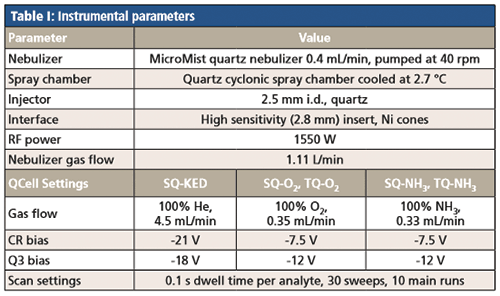
Results and Discussion
Two prominent examples for isobaric interferences are the detection of 87Sr (7.00% abundant in nature) in the presence of Rb, which also has an isotope with mass number 87 (87Rb is 27.84% abundant). Secondly, 204Pb (1.40% abundant) is interfered by 204Hg (6.85% abundant), which is of special concern for geological applications, where the 204Pb isotope is often used as a reference isotope (because it is not affected by radioactive decay of U or Th).
Using single-quadrupole ICP-MS, strontium is typically analyzed using kinetic energy discrimination to make sure polyatomic interferences are removed, but also use of the standard mode (no interference removal) may be feasible depending on the sample. For removal of the isobaric interference of 87Rb, oxygen can be used as a reactive gas in the CRC system. Whereas Sr undergoes an oxidation reaction and hence forms product ions with m/z 103 (87Sr16O+) and 104 (88Sr16O+) respectively, 87Rb does not react with oxygen. If the analyzing quadrupole of either a single- or triple-quadrupole ICP-MS system is set to scan m/z 103 and 104 under these conditions, only Sr will be detected. However, only triple-quadrupole instruments can filter out ions potentially interfering at the new product ion mass of Sr, such as 103Rh+, 104Ru+, or 104Pd+. Figure 1 shows how all quadrupoles need to be set to scan for this application.
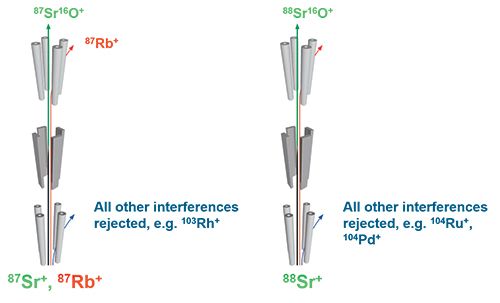
Figure 1: Schematic illustrating the analysis of strontium isotopes in presence of Rb using triple-quadrupole ICP-MS operated with oxygen as reaction gas.
To evaluate the performance in different measurement modes for Sr, a calibration curve was acquired using SQ-KED as a reference, and using triple-quadrupole MS in combination with oxygen as a reactive gas. The resulting detection sensitivity using oxygen and a mass shift reaction was about 30% in comparison to SQ-KED (14 kcps/µg/L in comparison to 51 kcps/µg/L); however, the instrumental detection limit was not affected (0.001 µg/L for 88Sr in both modes of analysis).
In a second experiment, solutions containing 10 µg/L and varying concentrations of Rb were analyzed and the isotope ratio 88Sr/87Sr was evaluated. Furthermore, solutions containing equal amounts of Sr and Rb in a matrix containing either or both 1 mg/L of Pd and 10 mg/L of Ru (to account for the lower abundance of the 104Ru isotope in comparison to monoisotopic 103Rh) were analyzed. Typically, considering the isotopic abundance of the strontium isotopes 87Sr and 88Sr, one would expect a theoretical isotope ratio of 11.7971. The results are displayed in Table II.
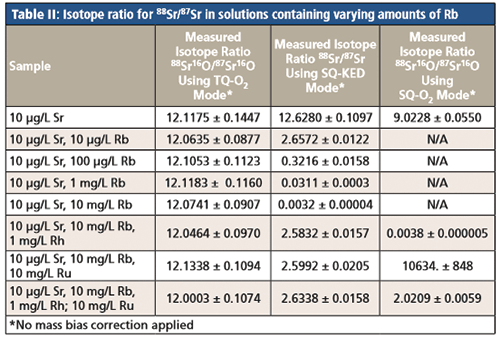
As can be seen from Table II, the increasing amount of Rb (and hence the abundance of ions with m/z 87) has no effect on the Sr isotope ratio when using the TQ-O2 mode. In contrast, the single-quadrupole approach using KED reveals a strong effect of the increasing amount of Rb in the sample solution, because the isobaric interference is not resolved. When using oxygen as a reactive gas in single-quadrupole ICP-MS analysis, the obtained isotope ratio is mainly determined by the interfering ions on the product ion mass of 87, 88Sr16O, which are not removed and remain occupied, since neither Rh nor Ru react with oxygen. Even the observed isotope ratio for a solution containing only Sr is strongly biased by other ions of unknown identity formed in the cell.
For Pb, similar experiments were conducted to estimate the effect of the isobaric interference caused by 204Hg on 204Pb. To judge how far the isobaric interference was eliminated, the isotope ratio 204Pb/208Pb (reference value 0.02672) was used as a reference.
For elimination of the isobaric interference from Hg on Pb, a reaction with ammonia can be used. Hg undergoes a chemical reaction with ammonia molecules and forms product ions that have a different m/z value. At the same time, Pb does not react with ammonia, so it can be detected free from interferences when the analyzing quadrupole (Q3) is set to the same mass as the first quadrupole (that is, mass 204 in this case). It is therefore important to avoid other reactions in the cell that could lead to the formation of a product ion with m/z 204, so lower mass ions that could generate additional interferences need to be removed in the first quadrupole. Again, the objective was to investigate how far traditional single-quadrupole approaches in comparison to triple-quadrupole operation may be suitable for this application. For the single-quadrupole mode tests, ammonia was also used as the reactive gas, but with Q1 acting as an ion guide only, so that other ions also originating from the sample could enter the CRC system.
Table III clearly shows that, again, KED does not enable the removal of isobaric interferences, as the measured isotope ratio changes with increasing concentration of Hg added to the solution. In contrast, the use of NH3 as a reactive gas in single-quadrupole mode is capable of eliminating the isobaric 204Hg interference from 204Pb. Because no other ions are present in the ion beam when analyzing a solution containing only Hg and Pb, the use of an additional mass filter or of Q1 as an ion guide is unnecessary. However, for real sample analysis this situation is almost never the case. If for example rare-earth elements are present in the sample solution (which is likely in geological samples such as soils or rock digests), other cluster ions may be formed with NH3, so that m/z 204 is again interfered. To test this phenomenon, 1 mg/L of ytterbium was added to the measured solution to introduce 170Yb(NH3)2 as a potential interference on 204Pb in SQ-NH3 mode. Again, a biased 204Pb/208Pb isotope ratio is observed, clearly showing that there is an effect from 170Yb(NH3)2 interference on 204Pb in SQ-NH3 mode. To visualize this newly formed polyatomic interference, a full mass spectrum was acquired using NH3 as reactive gas (Figure 2).
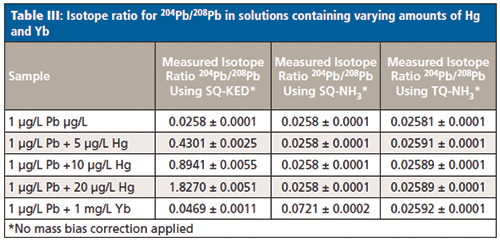
It can be seen that there are numerous cluster molecules formed from Yb and NH3. Although unreacted Yb still shows the highest abundance in the mass spectrum between m/z 168 and 176 (indicating that the reaction is not quantitative), the characteristic isotope pattern for Yb can also be repeatedly found at higher mass, with an equal distance of 17 amu between corresponding isotopes. This mass difference reveals the successive addition of one molecule of NH3 per precursor ion and is characteristic for reactions of this gas. The main interference now found on m/z 204 corresponds to 170Yb(14N1H3)2+, but since all seven Yb isotopes react in the same way, the other Pb isotopes would also be similarly interfered. In SQ-NH3 mode, these newly formed polyatomic ions are transmitted with the isotope mass of interest and therefore introduce a new interference on the target isotope. In contrast, when switching to a triple quadrupole–based measurement mode (TQ-NH3), all other ions with lower mass (such as 170Yb) are removed from the ion beam before they enter the CRC system and are not able to generate these new interferences. The side reaction of Yb with NH3 therefore does not lead to the formation of new interferences on Pb, and in turn, the 204Pb/208Pb measured isotope ratio is not affected at all through the presence of either Hg or Yb. Furthermore, other rare-earth elements that may lead to the formation of new interferences on 204Pb because of their reactivity toward ammonia-for example, cerium (136Ce[14N1H3]4+, 0.19% abundant) or europium (153Eu[14N1H3]3+, 52.20% abundant)-are also removed by Q1 in triple-quadrupole mode.
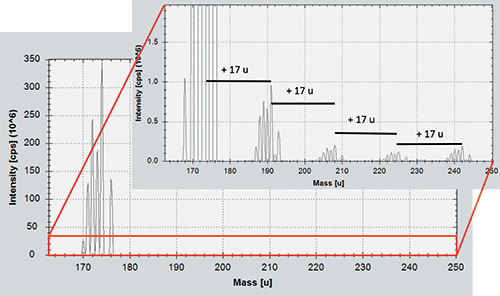
Figure 2: Full mass spectrum illustrating the formation of Yb-derived product ions acquired using single-quadrupole operation and ammonia as reaction gas.
Conclusion
The removal of isobaric interferences using reactive gases has been demonstrated in two examples, 87Rb on 87Sr and 204Hg on 204Pb. Leveraging different reactivity toward oxygen and ammonia, respectively, allows a chemical separation of the isobars inside the CRC system. Although single-quadrupole instruments are also capable of using reactive gases, unwanted side reactions with other elements present in the sample may lead to the formation of new interferences, as has been shown in the case of Yb and Pb. The importance of controlling the ions entering the CRC is a key factor with respect to obtaining analytical accuracy. Triple-quadrupole ICP-MS using a dedicated mass filter in front of the CRC system is the only definitive way of achieving this required ion transmission control.
Daniel Kutscher and Shona McSheehy Ducos are with Thermo Fisher Scientific in Bremen, Germany. Simon Lofthouse and Simon Nelms are with Thermo Fisher Scientific in Stafford House, Hemel Hempstead, UK. Direct correspondence to: daniel.kutscher@thermofisher.com

High-Speed Laser MS for Precise, Prep-Free Environmental Particle Tracking
April 21st 2025Scientists at Oak Ridge National Laboratory have demonstrated that a fast, laser-based mass spectrometry method—LA-ICP-TOF-MS—can accurately detect and identify airborne environmental particles, including toxic metal particles like ruthenium, without the need for complex sample preparation. The work offers a breakthrough in rapid, high-resolution analysis of environmental pollutants.
Trending on Spectroscopy: The Top Content of 2024
December 30th 2024In 2024, we launched multiple content series, covered major conferences, presented two awards, and continued our monthly Analytically Speaking episodes. Below, you'll find a selection of the most popular content from Spectroscopy over the past year.